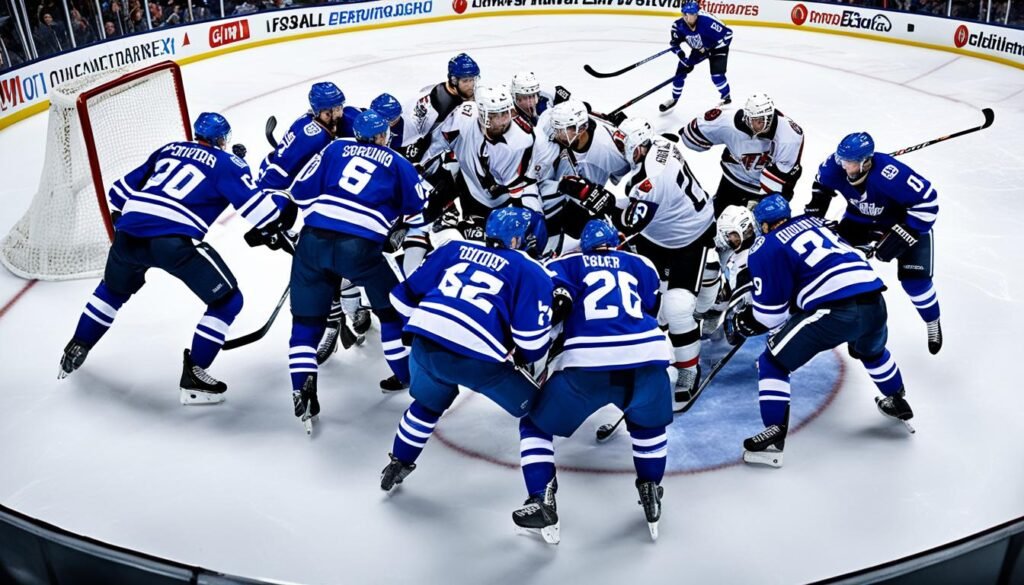How Many Periods in Hockey? Game Structure Explained

Hockey thrills fans worldwide with its fast-paced action. The game’s structure is defined by its periods and durations. Knowing the standard format helps fans follow the sport’s rhythm and progress.
A typical hockey match has three 20-minute periods. Between periods, players rest for 15 to 18 minutes. This break allows for rink cleaning and fan engagement.
Key Takeaways
- A standard hockey game consists of three 20-minute periods.
- Intermissions between periods typically last 15 to 18 minutes.
- The three-period system originated to allow for more frequent rink cleanings, player rest, and fan engagement.
- The three-period structure has remained consistent in the NHL for over 100 years.
- Women’s hockey follows the same three-period format as men’s hockey.
The Standard Three-Period Structure
Hockey games are split into three 20-minute periods. This format is common in many leagues. Players get 15 to 18-minute breaks between periods to rest and prepare.
Duration of Periods and Intermissions
The game clock stops during play interruptions. This ensures each period has 20 minutes of actual play. Despite this, a full game typically lasts about 2.5 hours.
Stoppages and Timeouts
Play stops for various reasons like icing, offside infractions, and penalties. Each team gets one 30-second timeout per game. This can be used for rest or to discuss important strategies.
Impact of Periods on Player Strategy
The three-period structure greatly affects player tactics. Teams must manage line changes and player rotation carefully. Coaches need to adapt to scores, handle penalties, and deal with player fatigue.
These factors are crucial for navigating the ups and downs of a hockey game. Proper management can make the difference between winning and losing.
| Statistic | Value |
|---|---|
| Standard Periods | 3 |
| Period Length | 20 minutes |
| Intermission Length | 15-18 minutes |
| Total Game Duration | Approximately 2.5 hours |
“The three-period structure of a hockey game is a fundamental aspect of the sport, allowing for strategic adjustments and player management throughout the course of the competition.”
Overtime and Sudden Death
Hockey games don’t always end after three periods. If tied, an overtime period determines the winner. Hockey overtime rules vary between regular season and playoffs, adding excitement and strategy.
In NHL overtime during regular season, teams play five minutes with three skaters each. This “sudden death” format means the first team to score wins. Playoff overtimes use full 20-minute periods with five skaters per team.
The sudden death format continues until a goal is scored. This secures victory for the scoring team. Sudden death hockey rules have changed over time.
Overtime was introduced in 1921 with a 20-minute period. It was reduced to 10 minutes in 1927. In 1983, it became the current five-minute format.
The NHL eliminated draws in 2005. They introduced shootouts to ensure a winner in regular season games. Overtime is an unpredictable and thrilling part of hockey.
The 3-on-3 format and 5-on-5 playoff battles are exciting. These sudden death rules add suspense and drama to the game. They captivate both fans and players alike.
Shootouts and Tiebreakers
Hockey games don’t always end with the final buzzer. After a tied overtime, a thrilling hockey shootout decides the winner. Three players from each team take penalty shots in a best-of-three format.
If the shootout remains tied, it moves to sudden-death. One player from each team shoots until a winner emerges. This hockey tiebreaker rule ensures an exciting finish for everyone involved.
Playoff games don’t use the shootout format. Instead, they use full 20-minute sudden-death overtime periods. This continues until a goal is scored, highlighting different strategies for regular season and playoffs.
| Regulation | Overtime | Shootout |
|---|---|---|
| 3 Periods (20 minutes each) | 5-minute 3-on-3 (regular season) 20-minute 5-on-5 (playoffs) |
Best-of-three rounds Sudden-death after initial rounds |
Knowing hockey shootout rules and hockey tiebreaker procedures helps fans enjoy the game more. These elements add drama and excitement to hockey. They test players’ skills and keep fans on the edge of their seats.
“The shootout is one of the most exciting aspects of the game. It really tests the skill and composure of the players, and the tension is palpable for both teams and the fans.”
Penalties and Power Plays
Penalties are game-changers in hockey. When a player fouls, they sit out for 2-5 minutes. This creates a power play for the opposing team, giving them a player advantage.
Power plays can swing game outcomes. Teams use special units and formations to score during these chances. The shorthanded team focuses on defense and puck control to limit scoring opportunities.
Sometimes, both teams have players in the penalty box. This leads to equal strength on the ice and a more balanced game.
Penalty and power play stats shape game strategy. Coaches and players track these metrics closely. They can greatly impact the final score of a hockey match.

“Penalties can make or break a game. It’s all about capitalizing on those power play opportunities and staying disciplined on the defensive end.”
Penalties and power plays are key to hockey’s excitement. Teams must balance aggression and control to win. This dynamic adds depth to the sport’s strategy and appeal.
how many periods in hockey
Hockey games follow a simple three-period system. Professional hockey, including NHL games, has three 20-minute periods. Two intermissions, each lasting 15-18 minutes, separate the periods.
This structure has been used in hockey for over 100 years. It allows players to rest and teams to adjust strategies. The clock stops during penalties, goals, and timeouts.
Most games last between 2.5 to 3 hours in real-time. Each team gets one 30-second timeout per game. Overtime periods and shootouts may be used to break ties.
The three-period format is common across various hockey leagues. These include the IIHF World Junior Championship, NCAA hockey, and minor leagues. Rules may differ, but the core structure remains the same.
| Hockey Game Periods | Duration |
|---|---|
| First Period | 20 minutes |
| Second Period | 20 minutes |
| Third Period | 20 minutes |
| Intermission | 15-18 minutes |
Hockey’s three-period structure creates an exciting experience for everyone involved. The breaks between periods allow players to rest and regroup. This format keeps the game balanced and engaging throughout.
Special Game Conditions
Hockey games sometimes go beyond the usual three periods. These special cases happen when a game ends in a tie after regular time.
Overtime and Sudden Death
Tied games go into overtime to find a winner. Rules differ for regular season and playoffs. In regular season, there’s a 5-minute 3-on-3 overtime, then a shootout if needed.
Playoffs use 20-minute sudden-death periods until someone scores. The first team to score wins the game.
Shootouts and Tiebreakers
Regular season games use shootouts if overtime doesn’t break the tie. Each team picks three players for penalty shots. The team with more goals in three rounds wins.
If still tied, the shootout becomes sudden-death. Playoffs don’t use this tiebreaker method.
| Season | Overtime Games | Shootout Games | Shootout Percentage |
|---|---|---|---|
| 2018-19 | 138 | 62 | 45% |
| 2017-18 | 136 | 68 | 50% |
| 2016-17 | 149 | 55 | 37% |
| 2015-16 | 168 | 84 | 50% |
The NHL’s longest shootout lasted 20 rounds. It was between the Florida Panthers and Washington Capitals.

Factors Affecting Game Duration
Several factors can change how long a hockey game lasts. These include TV broadcasts, whistle stops, and power plays. These elements show how dynamic hockey can be.
Television Broadcasts
National TV games often have extra commercial breaks. This can make the game longer. TV timeouts happen at set times in each period.
They occur after the 6, 10, and 14-minute marks. These breaks can add several minutes to the game clock.
Whistle Stoppages
The number of whistle stops can greatly affect hockey game length. The clock stops every time the referee blows the whistle.
This can happen for penalties, injuries, goals, or puck going out of play. More stoppages mean a longer game.
Power Plays
Power plays can make hockey games longer. The clock keeps running during a power play.
The team with fewer players often “ices” the puck. This causes more stops and extends the game.
| Factor | Impact on Game Duration |
|---|---|
| Television Broadcasts | Additional commercial breaks and TV timeouts can add several minutes to the game clock. |
| Whistle Stoppages | Frequent stoppages for penalties, injuries, goals, and puck out of play can significantly extend the game length. |
| Power Plays | The shorthanded team’s strategy to “ice” the puck can lead to more stoppages and a longer overall game. |
These factors help fans understand why hockey games can vary in length. They show how unpredictable and exciting the sport can be.
“The longest hockey game in history lasted 176 minutes and 30 seconds, going through six overtimes before a winner was determined.”
Variations Across Leagues
Hockey game structures differ across various leagues and levels. The NHL is the most well-known, but other leagues have unique formats. Let’s explore how game formats vary in different hockey organizations.
IIHF World Junior Championship
The IIHF World Junior Championship follows a three 20-minute period format. If tied after regulation, a 10-minute sudden-death overtime follows. A shootout decides the game if overtime ends without a goal.
NCAA Hockey
NCAA hockey also uses three 20-minute periods. Tied games go to a 5-minute sudden-death overtime. Regular season games can end in ties after overtime.
Conference playoffs and NCAA tournaments use 20-minute sudden-death overtime periods. These continue until a winner emerges, similar to NHL playoffs.
Minor League Hockey
Minor leagues like the AHL and ECHL use the same three-period structure as the NHL. Overtime rules may vary depending on the specific league and situation.
These format differences impact game duration and team strategies. Understanding them helps fans appreciate the sport’s nuances at various competition levels.
Conclusion
Hockey games have three 20-minute periods with two breaks in between. This format has been used in professional hockey for over 100 years. It allows players to rest and teams to adjust their game plans.
The basic structure is consistent, but game duration can vary. Overtime, shootouts, penalties, and TV broadcasts can affect how long a game lasts. These factors make each hockey match unique and exciting for fans.
The three-period system enhances player safety and performance. It also adds strategic depth to the game. This structure meets both commercial needs and entertainment demands. Understanding hockey’s format increases appreciation for the sport’s history and thrilling action.
FAQ
How many periods are in a hockey game?
A standard hockey game has three 20-minute periods. Between periods, there are two 15-18 minute intermissions.
What is the duration of a hockey game?
A typical hockey game lasts about 2.5 hours in real-time. The clock stops during play stoppages, like when the puck goes out of bounds.
What happens during the intermissions in a hockey game?
During intermissions, teams regroup, plan strategies, and rest. This break helps players prepare for the next period on the ice.
How do the periods impact player strategy in hockey?
The three periods greatly affect players’ strategies. Teams adjust their lines and tactics throughout the game. They manage fatigue, adapt to the score, and respond to penalties and power plays.
What happens if a hockey game is tied at the end of regulation?
If a game is tied after three periods, an overtime period is played. The overtime rules are different for regular season and playoff games.
How are shootouts and tiebreakers used in hockey?
In regular season games, a shootout decides ties after overtime. Each team picks three players for penalty shots. The team with the most goals in this format wins.
If the shootout is tied, it becomes sudden-death. Players continue shooting until one team scores and the other doesn’t.
How do penalties and power plays impact a hockey game?
Penalties can greatly change a hockey game. When a player commits a foul, they may sit out for a set time. This creates a power play for the other team, giving them an advantage.
How do variations in leagues impact the structure of hockey games?
Not all hockey leagues structure their games like the NHL. The IIHF World Junior Championship uses different overtime rules. NCAA hockey also has unique game structures and overtime rules.
What factors can affect the duration of a hockey game?
Several factors can make a hockey game longer. These include TV broadcasts, whistle stoppages, and power plays. Such events can lead to more interruptions and extend the game’s overall length.





